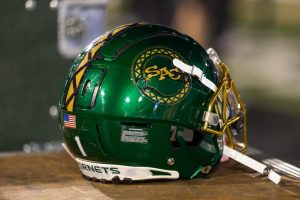CSUS named Tree Campus USA
November 7, 2012
The Arbor Day Foundation named Sacramento State a Tree Campus USA for its commitment of effectively managing the trees on campus.
Tree Campus USA is a program that recognizes universities and colleges in the United States for their preserved campus trees, their connection with the community to grow healthy forests in the area, their effort to engage their students in the process and for meeting the five standards.
Sac State earned the name by meeting the five Tree Campus USA requirements, which includes a campus tree advisory committee, a campus tree care plan, a campus tree program with dedicated annual expenditures, an Arbor Day observance and the opportunity for students to engage in a service learning project.
Sean Barry, director of media relations from the Arbor Day Foundation, said the program was founded in 2008 by the Arbor Day Foundation with support from Toyota. The program’s goal is to help “grow the next generation of environmental stewards” by giving students and staff the chance to participate in hands-on planting and conservation activities.
“We believe that young people become most invested in the environment and their surroundings when they roll up their sleeves and get dirt under their fingernails,” Barry said. “We also have seen that young people across the country really want to volunteer and give back to their community, and Tree Campus USA offers one way for them to do that on their own campuses.”
The program recognized five California college campuses as Tree Campus USA in 2011, and Sac State is the sixth campus to be recognized this year.
Robert Anchor, manager of the university’s grounds and landscape services, said Sac State has an ongoing maintenance program that has helped preserve the trees on campus, especially the ones that have been standing for years after the university first opened.
“We have certain money set aside to maintain the trees by outside contractors and by our maintenance department,” Anchor said. “The maintenance program we’ve had over the years has gone a long way to keep the trees in good shape as they are now.”
There are approximately 3,500 trees on campus and more than 400 species, said Anchor.
The idea to have Sac State recognized by the Arbor Day Foundation started with a seed that grew into a goal by senior biological sciences major Jasmine Greer.
The process started earlier in the year when Greer teamed up with the campus facilities services, the biology department, the Sacramento Tree Foundation, and student organizations including the Field Biology Group and the Environmental Student Organization to form a tree advisory committee.
Together, they completed the application for Tree Campus USA, which required the creation of a tree care plan by Sac State and its participation in the Arbor Day observance. Greer said the tree advisory committee and student volunteers planted a Paperbark Maple tree provided by the University Arboretum director, Mike Baad, in front of the Library Quad on April 7 as part of the Arbor Day observance.
Greer said it was important for Sac State to be named Tree Campus USA because of its “stewardship of beautiful trees,” the legacy of tree planting and the years of hard work to maintain and expand the trees on campus.
“Sacramento is a city of trees; it is only appropriate that our state college, which contributes greatly to the urban forest, (be) recognized as a Tree Campus USA,” Greer said. “The number and diversity of trees on our campus is very impressive and sets us apart from other CSU campuses, especially because we have an arboretum.”
The trees surrounding the campus offer more than scenery because they can provide cool shade during the hot weather, said Anchor.
“Having the trees in close proximity of the buildings is a very good energy savings ability, (because) trees provide the shade for the buildings,” Anchor said.
Greer said the campus trees represent a “wonderful, largely untapped resource” for campus-wide engagement and education that can be used by the community as an educational tool. Students from Sac State, middle schools and high schools can also take advantage of the trees to learn about the tree species and plants, said Anchor.
“It’s a learning garden – the arboretum is a classroom setting even for off campus classes like elementary schools and junior high kids that come and tour the campus,” Anchor said.
Greer said she feels grateful for Sac State being named a Tree Campus USA and she is glad to have been part of the initiative.
“I am just one component of the Tree Advisory Committee; this would not have happened without the support and expertise of Bob Anchor and Daryn Ockey in Facilities Services; Dr. Baad, the director of the university arboretum; Dr. Ron Coleman in Biological Sciences; and the Sacramento Tree Foundation,” Greer said.
The students in the Environmental Student Organization volunteered to help conduct the Tree Campus Summit that will occur on Nov. 14 from 1:30 to 2:45 p.m. at the University Arboretum Greer said. It will be a presentation made by the Arbor Day Foundation and the California Department of Forestry and Fire Protection representatives as they recognize Sac State as a Tree Campus USA. The summit will then be followed by a guest lecture at Hinde Auditorium from 3:20 p.m. to 4:15 p.m.
“We’ve always been proud of our trees. It’s a major heritage item here on campus,” Anchor said. “It’s one of the main reasons students like to go here because of the beautiful urban forest we have. I think one of the main advantages of being a Tree Campus USA is we put into place procedures for the trees that are going to insure the trees are going to be healthy for years to come.”
Leticia Lopez can be reached at [email protected]




























































































































